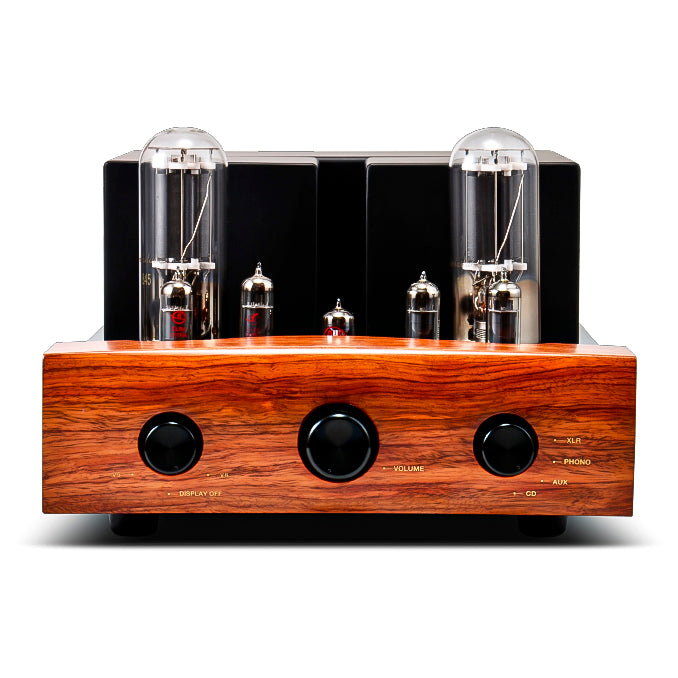Regeneration capability designed in the latest theory
I was selected.Beautiful speakers by solid materials and craftsmen
Featuring MAOP11MS new design - a speaker system that brings out a delicate, musical mono suspension sound
MAOP11_MS realizes an unprecedented reality with acoustic performance created by its unique single suspension design. In the early stages of development, a high failure rate was a challenge due to the difficulty of monospension assembly, but we finally succeeded in commercialization after improving the manufacturing process. The sound of this innovative driver unit brings a sense of realism as if the music is played in front of you, and once you hear it, you are drawn to the deep charm.

MAOP(Micro-Arc Oxidation Process)
MAOP treatment is the process of creating crystals while oxidizing the surface of the aluminum magnesium cone over a long period of time in a solution of an alkali electrolyte with a very strong voltage (700V). The effect is to dump a resonant wave of sound that is said to pass through the surface of a cone using metal by this crystal. In conventional metal cones, the micro-resonance pattern passing through this surface was transmitted to the frame as it is, but this MAOP treatment has realized the dumping effect close to the pulp cone with the metal cone itself, which was impossible until now. This is because it realizes very flat frequency characteristics and is said to be "a silky and silky smooth audio driver."

MAOP11v2 upgraded the driver unit to MAOPMS.MAOP11v2 same way, this model uses the finest voice coil using pure copper rectangle wire. The advantage of this coil is that it can be lightened by several tens of percent to the same magnetic force, linear resistance, self-resonance is suppressed, etc.The suspension is softer. The lower range is more dynamic and the fine representation capacity of the middle and high range is improved.
Paulownia hidden behind the front baffle
You can see that the color of the second layer of the bus reflex port is reddish.
This is because I got Japanese paulownia wood for musical instruments at the woodwork, so I changed it from cherry to solid cedar paulownia because it becomes a very musical sound when I listened to the prototype.
Paulownia solid material is lavishly attached to the whole back side of the baffle surface.
The material of the paulownia system has a unique fascinating sound quality. But because it is soft and light, it is generally less common as an enclosure material.
I was surprised when I listened, but I think that because the DF is high, it is good to use it in conjunction with the specific heavy walnut and maple material, and the drawbacks are suppressed.
The expression of hall tones and overtones is very attractive.

Non-magnetic metal plated OFC single wire for internal wiring
It is a very short internal wiring compared to the speaker cable hidden in the enclosure, but the sound changes drastically in this last one mile.
In order to maximize the goodness of MAOP11 and solid wood, we adopted two fully non-magnetic metal-plated OFC 0.7mm single-twisted wires made of amtrance, plus and minus (the only fully non-magnetic plated fluoropolymer PFA film in the industry).
Compared to conventional internal wiring, detailed sound expressiveness is improved as if the veil was removed.

Oval Bus Refport
The bass reflex sound is a bright, energetic and finished way of designing the speaker system.
On the other hand, some people prefer smooth acoustic suspension type but smooth and gentle characteristics up to ultra-low range.

Therefore, in order to reduce the sudden attenuation of the bus reflex, solid wood is superimposed and the oval structure is adopted, the resonance frequency is set to low, and the resonance frequency is lowered 35Hz. I aimed for "good togetori" with basleff and sealedIt is designed for adult tone bass reflex close to closed type. Version 2 adjusts the length of the bus reflex port and improves the sound pressure from 40 to 45 Hz .
Golden Ratio
The Golden Ratio enclosure, which was tuned after listening, uses walnut or maple materials on both sides of the baffle board, and aims to be like the finest furniture, naturally harmonizing with the modern living room design.
Xmax8.0
Two types of solid wood (hard maple walnut) have different tones.
Expressing this difference is a little difficult work, but...
The rigid maple material does not attenuate high range, so the rise is very good and the reverberation is good. It is recommended for genres that have melody and contrast.
Walnut is ideal for classical performances in halls that take advantage of reverberation.
A walnut that expands and warms the sound in a plump, and a hard maple with a focus that the feeling of the cymbal is determined and the slot of the trumpet can be seen in front of you.
Each sound is contrasting.
We will work hard to maintain common sense pricing so that you can enjoy music with your favorite genre and everyone.
Please consider the design and coordination of the room.
The beauty of the Nature Collection series is more beautiful than the luxury furniture of the living room by selected materials and careful processing by experienced craftsmen.
Difference between and
The difference between NC11 and NC7 sound quality makes NC7 more delicate than NC11, making it ideal for listening to string chamber music. In contrast, the NC11 demonstrates its true value in grand spatial expressions such as classical concerts in large halls and organ performances in churches.
The maximum input is for NC7 units, but the tolerance increases by fitting into the enclosure and . Since the unit is 35W for NC11, the actual maximum input is about 45W.
Since mark audio speakers provide data that is designed and adjusted not only for viewing the front of the audio set but also for viewing the wonderful sound even in the offset state, it may seem inferior when comparing only the specs with other products.
| SP Unit | MAOP_11MS |
|---|---|
| Playback frequency | 35Hz-25,000 Hz |
| Maximum Input | 35W (cont.) |
| Output sound pressure level | 87dB /1w@1m |
| Rated impedance | 7.2Ω |
| MMS (total weight of drive part) | 7.90 g |
| Xmax (amplitude )/1way | 8.0mm |
| Dimensions | 245 x 450 x 295 mm |
| Weight | 11.5kg |




































